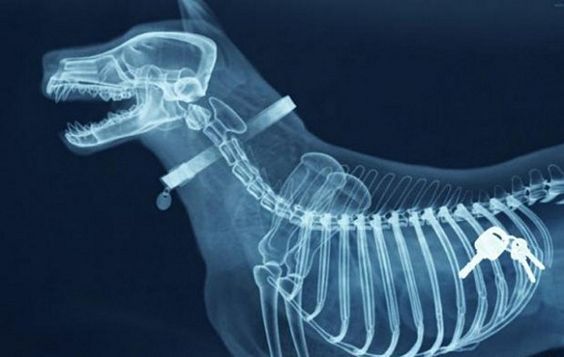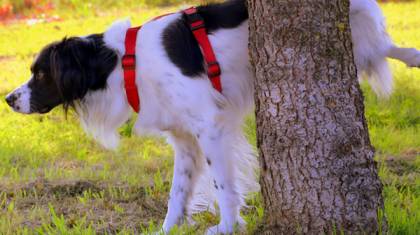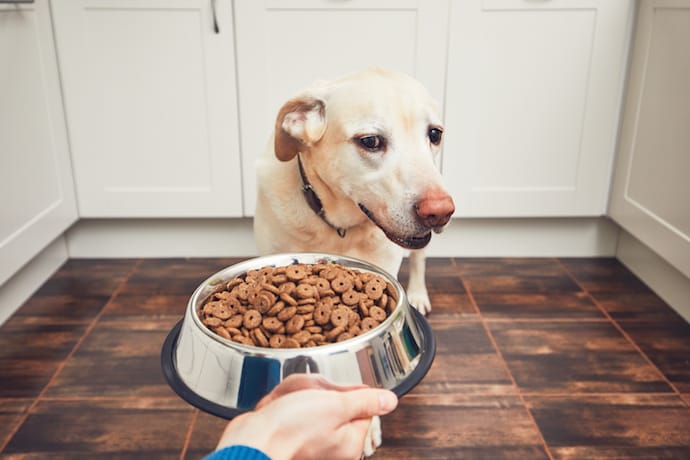Canine degenerative myelopathy is a rare, inherited disease that can affect dogs of any breed, but is most often seen in purebred dogs. This devastating disease is degenerative, meaning that the process starts in one spot and then spreads.
Connect with a verified veterinarian in minutes. Licensed vets are available 24/7 to answer your questions. No need to worry about your furry family member.
What is Canine Degenerative Myelopathy?
Canine degenerative myelopathy (DM) is a (currently) incurable disease that progressively worsens over time. It affects a dog’s spinal cord and is similar to ALS (amyotrophic lateral sclerosis) in humans. This condition usually hits older dogs anywhere from 7 years of age and older. It’s most often seen in these dog breeds:
- American Eskimo Dogs
- Bernese Mountain Dogs
- Borzoi
- Boxers
- Cardigan Welsh Corgis
- Chesapeake Bay Retrievers
- German Shepherds
- Golden Retrievers
- Pugs
- Wire Fox Terriers
This is not an exhaustive list; in fact, any breed of dog can develop this disease.
Canine degenerative myelopathy causes progressive weakness and coordination issues with the hind legs. In fact, this is the first place the disease is often noticeable. Over time, the weakness progresses to other parts of the body, eventually leading to paralysis. A dog with degenerative myelopathy life expectancy may survive anywhere from 6 months to a year after diagnosis.
Researchers have found that the condition seems to be an inflammatory autoimmune disease. The disease process involves destruction of the myelin (nerve sheath), which insulates and protects nerve fibers in the spinal cord. The dog’s immune systems starts to attack the sheath covering, which creates inflammatory cells and chronic inflammation that continue to destroy the myelin.
The nerves are damaged, and the dog experiences a loss of motor control (both voluntary and involuntary)
Genetic Testing
There is a test available to see if a dog carries the SOD1 mutation, which causes DM. The test will determine if a dog is a carrier, has normal copies of the gene or can help determine if a dog will develop degenerative myelopathy in the future. It’s important to note that while this test is helpful, it’s not able to determine if a dog has DM.
Diagnosis
There are no medical tests just for this disease, which means testing will be a matter exclusion. If tests are negative for other medical conditions that cause similar symptoms, then more than likely the dog has degenerative myelopathy.
Typical diagnostic tests include blood work, spinal X-rays, EMG (electromyogram), MRI, CT, myelogram, and possibly a spinal tap. These tests are given to rule other medical problems, such as degenerative disc disease, tumors on the spinal cord, etc.
Symptoms
Symptoms of degenerative myelopathy may include:
Early stage:
- Weakness in hind legs
- Nails worn down
- Dragging of feet while walking (called knuckling)
- Scuffing hind feet
- Trouble with coordination
- Wobbly gait
- Slow reflexes
- Atrophy of thigh muscles and/or tail
- Tremors in the hind legs
Late Stage:
- Incontinence (urinary and fecal)
- Stress & anxiety
- Pressure sores
- Unable to stand up/lie down
- Muscle weakness
- Pneumonia
- Front leg weakness
- Constipation
- Infections (could develop sepsis)
Emergency
- Trouble breathing
- Seizures
- Uncontrollable diarrhea or vomiting
- Sudden collapse
- Bleeding (profuse—internal or external)
- Degenerative myelopathy whining or crying
Eventually, the disease will progress, and the dog will have trouble standing, getting up or even lying down. They may also develop incontinence issues due to muscle weakness or paralysis. Over time, paralysis spreads to the front legs. This disease causes no direct pain, though pain can develop from arthritis or from dragging limbs and feet.
Dog Degenerative Myelopathy Treatment
The main goal of treatment is to keep the dog as comfortable as possible and help the dog maintain quality of life. Pet parents can expect that their fur baby will become completely dependent on them, needing constant supervision, help to stand and walk, etc.
Moderate forms of exercise are recommended to help keep muscle deterioration and atrophy at bay as long as possible. In addition, pet parents can help their canine companion with range of motion exercises, which are stretches. These can also help delay progression of the disease and keep the dog’s muscles stronger for a longer period. Additional treatments may include swimming, use of an underwater treadmill, or other water exercises and activities.
Additionally, dogs will require padded bedding to provide a comfortable place to lay down. It will also be necessary for pet parents to watch and treat any skin problems, such as bed sores, skin problems from urine and or feces. A special wheel cart may be needed at some point to help keep the dog mobile as long as possible. Diet can also help a dog with DM, by helping him to avoid obesity. Being overweight or obese causes more stress and mobility issues as the disease progresses.
Additional therapies may include acupuncture and mild exercise. Should you walk a dog with degenerative myelopathy? The short answer is yes, as long as you keep the walk focused and short. However, expect that a wheel cart will be necessary eventually, once the hind legs no longer function.
What About Medication?
Up to now, medications have not proven helpful in the disease. However, vitamins and Omega-3 fatty acid have been said to be helpful, though these therapies are not supported by scientific research.

Review symptoms, medications & behavior to keep your pets healthy with a Vet Online in just minutes.
Ask a Vet Live NowWhen to Put Down a Dog with Degenerative Myelopathy
It’s hard to decide when to put down a beloved pet any time. With DM, it’s a matter of assessing the dog’s quality of life. Does the dog still enjoy some mobility to sniff around the yard, spend time with loved ones, etc.? Would he adapt to using a wheel cart, once his rear legs no longer function? Does he still seem to enjoy life, even with limited mobility?
Another issue is pain. While the disease itself does not cause pain, the process of dragging legs can cause pain in a dog’s rear end. They may also fall and hurt themselves, suffer from pressure sores, etc. Eating and drinking are another thing to consider. Does the dog still have a good, healthy appetite? Or is he eating only a little or refusing food? Comfort is also very important to consider. Can the dog sleep well and comfortably? Is he comfortable when lying down, etc.?
These are just a few of the things to consider when it comes to your dog’s quality of life. Euthanizing a pet is heartbreaking, but if he’s just so unhappy and uncomfortable, it may be the kindest thing to let him go.
Once you can decide when it’s time, though your vet may also be willing to help guide your decision
Life with DM—Making Your Dog Comfortable and Happy
Keeping your dog happy and comfortable for as long as possible is the main goal with a DM diagnosis. Finding ways to keep him mobile and active as much as he’d like is challenging, but not impossible. For instance, experiment to find what your dog is still able to do and would like to do. You may need to get a little creative when it comes to activities your fur baby can still enjoy, but don’t give up! Maybe he would enjoy holding a ball or other favorite toy in his mouth…or he might even enjoy watching you fetch the toy for him! If you’re in the backyard, maybe he’d enjoy biting at the water hose! Try to find what he’s still interested in doing and give it a go.
You might consider a cart when your dog’s hind legs no long function. Some dogs will be happy with the cart, while others may hate it. If your dog doesn’t enjoy the wheeled cart, then consider taking him for walks in a stroller! As the disease progresses, you’ll have to expect your dog will develop potty issues. You might consider doggie diapers, for instance. Along with this problem, you’ll have to keep your pup’s back end clean. If he has longer fur, consider keeping the fur around his tail clipped short, which makes it easier to clean and keep clean. Pet or baby wipes can help, but you’ll have to bathe your pal or at least give his rear quarters a wash regularly to avoid urine burns and other problems.
Other issues you’ll need to watch for are pressure or bed sores, skin problems (such as skin allergies), urinary tract infections, constipation, etc. Your vet will be happy to give you advice on how to treat these issues. Also be sure to keep your dog hydrated. As the disease progresses, he’ll have a harder time reaching his water bowl on his own. Keeping him regular “watering” schedule will ensure he stays hydrated, which just helps his overall well-being. Keep your dog at a healthy weight—when he’s no longer able to run, your dog may begin to put on weight. Additional weight will make degenerative myelopathy that much harder for him and you. You’ll have a harder time lifting and carrying an overweight or obese dog.
When it comes to nutrition, don’t skimp. A balanced diet filled with nutrients that support the immune system and fight inflammation will help your dog the most. High-quality proteins are a must. And don’t forget anti-inflammatory ingredients including polyunsaturated fatty acids (such as omega-3). Antioxidants can also be helpful, including vitamin C, vitamin E, vitamin A, carotenoids, selenium, and coenzyme Q-10.
Here is a list of foods that help fight inflammation, which are safe for dogs:
- Apples
- Apricots
- Cherries
- Berries
- Melons
- Peaches
- Pears
- Mangos
- Papaya
- Spinach
- Chard
- Carrots
- Sweet potato
- Pumpkin
There are also a few herbs that are safe for dogs and are recommended for DM:
- Devil’s claw
- White willow
- Grapeseed extract
- Bromelain
- Rosehips
- Chamomile
- Curcumin
- Comfrey
- Feverfew
- Yarrow
The most important thing to help your dog stay strong is to give him the best possible diet. It’s OK to use herbs, too, but be sure to check with your vet before adding any new items to your dog’s diet.
We hope this article has provided you with some information about the disease and some helpful tips on how to care for a dog who develops this disease. While the prognosis isn’t good, it is possible to make your dog’s remaining days happy and comfortable. It just takes a little creative effort and commitment on your part to make this time with your fur baby precious and special, in spite of DM.
Connect with a verified veterinarian in minutes. Licensed vets are available 24/7 to answer your questions. No need to worry about your furry family member.

Tom
Tom has always loved to write since he was little - he wanted to be either a writer or a veterinary doctor, but he ended up being a professional writer while most of his works are based on animals. He was born in San Francisco but later moved to Texas to continue his job as a writer. He graduated from the University of San Francisco where he studied biotechnology. He is happily married and a soon to be father!
Review symptoms, medications & behavior to keep your pets healthy with a Vet Online in just minutes.
Ask a Vet Live Now



